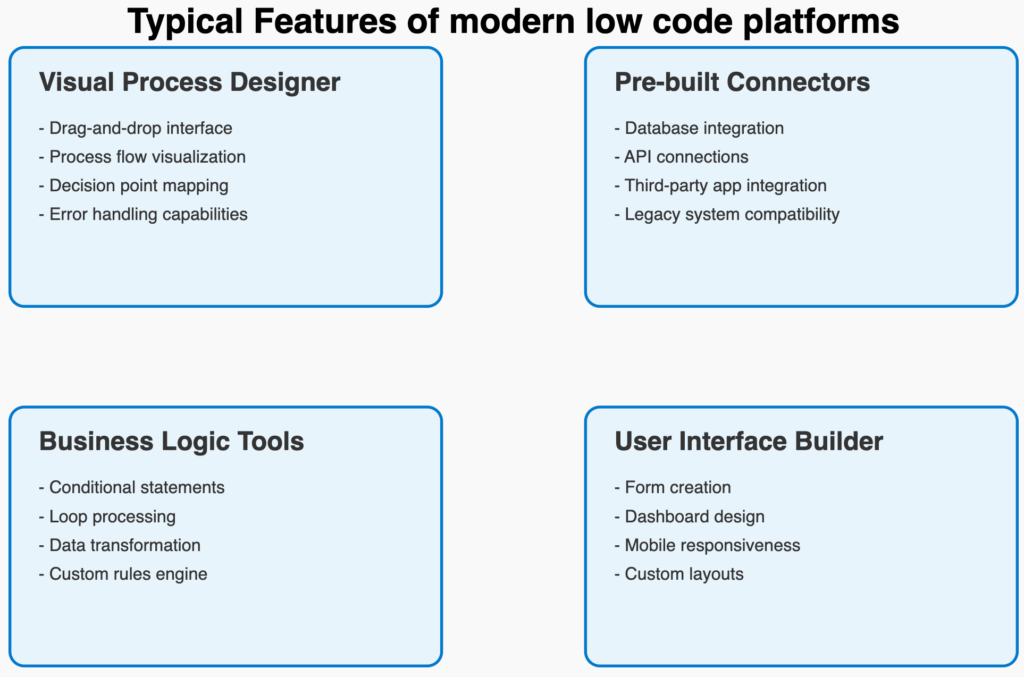Introduction
Imagine reducing your business process development time by 90% while simultaneously cutting costs and empowering your team to create powerful automation solutions. That’s not just a fantasy – it’s the reality of low code business process automation in 2025.
Let me share something that recently blew my mind: According to Forrester Research, the low code development platform market is projected to exceed $21 billion by 2025. This explosive growth isn’t just about numbers – it represents a fundamental shift in how businesses approach automation and digital transformation.
I remember when automating business processes meant either hiring expensive developers or struggling with complex coding languages. Those days are over. Low code automation has democratized process improvement, putting the power of automation directly into the hands of business users who understand their processes best.
Here’s what’s particularly exciting about low code automation in 2025:
- Business users can create complex workflows without extensive coding knowledge
- Solutions can be deployed in days or weeks instead of months
- Companies are seeing ROI within weeks of implementation
- Integration capabilities have reached new heights of sophistication
Think of low code automation as building with LEGO blocks instead of forging each piece from scratch. You get pre-built components that you can drag, drop, and connect to create powerful business applications and automated workflows. Whether you are looking to streamline your HR processes, automate customer service responses, or create sophisticated approval workflows, low code platforms make it possible without writing thousands of lines of code.
In this guide, I will explore everything you need to know about low code business process automation. From understanding the core concepts to selecting the right platform, implementing your first automation, and scaling your solution – read ahead and find it out.
What is Low Code Business Process Automation?

So what is the difference between low-code and no-code?
Low-code platforms provide a balance between customization and simplicity, allowing users to write code for greater flexibility and control. They excel in supporting complex integrations and handling sophisticated business logic, making them ideal for mid to complex processes. In contrast, no-code platforms require no coding, relying on predefined functions for ease of use. While less flexible, they are perfect for simple workflows and basic automations, offering a more accessible solution for straightforward tasks.

Benefits of Low Code Business Process Automation
Low-code automation offers compelling advantages over traditional coding. It accelerates time to market by enabling rapid prototyping, quick testing, and iterative development, reducing development time by up to 90%. Businesses save costs with minimal training requirements, lower development expenses, and reduced maintenance efforts. Its accessibility empowers non-technical users, reduces reliance on IT, and fosters collaboration across teams.
Low-code platforms provide flexibility with scalable solutions, easy modifications, and quick adaptability, while ensuring quality through standardized components and built-in best practices, minimizing human error. As businesses aim to stay competitive, low-code automation is democratizing digital transformation, making process automation accessible to all, and setting a new standard for efficiency in 2025 and beyond.
Top Low Code Automation Platforms in 2025
Choosing the right low code automation platform can feel overwhelming. Having worked with multiple platforms across different business scenarios, I wll break down the top contenders and help you understand which might be the best fit for your needs.
Microsoft Power Automate

Overview
Microsoft Power Automate (formerly Flow) has evolved into a powerhouse for business process automation, especially for organizations already in the Microsoft ecosystem.
Key Features:
- Deep Microsoft 365 integration
- AI-powered automation
- Robust security features
- Desktop and cloud automation
- Pre-built templates
Pricing:
- Free plan available
- Per user plans from $15/month
- Premium features from $40/month
Best For:
- Microsoft-centric organizations
- Enterprise-level automation
- Complex workflow requirements
OutSystems

Overview
OutSystems is a comprehensive low code platform that excels in creating enterprise-grade applications and automated workflows.
Key Features:
- Full-stack development capabilities
- Advanced security features
- Scalable architecture
- Visual development environment
- Extensive integration options
Pricing:
- Custom enterprise pricing
- Free trial available
- Development environment included
Best For:
- Large enterprises
- Complex application development
- Mission-critical processes
Mendix

Overview
Mendix offers a powerful combination of low code and traditional development capabilities, making it ideal for organizations needing flexibility.
Key Features:
- Multi-cloud deployment
- Native mobile development
- AI-assisted development
- Collaboration tools
- Extensive marketplace
Pricing:
- Free single-user version
- Standard: $50-$800/month
- Enterprise: Custom pricing
Best For:
- Cross-platform development
- Mobile-first applications
- Enterprise scalability
Appian

Overview
Appian specializes in business process automation with a focus on enterprise workflows and case management.
Key Features:
- Process mining capabilities
- RPA integration
- AI/ML components
- Low code data integration
- Enhanced security
Pricing:
- Custom pricing based on needs
- Enterprise-focused model
- Volume-based options
Best For:
- Process-heavy industries
- Regulated environments
- Large-scale automation
Bubble

Overview
Bubble stands out for its ability to create web applications without traditional coding, making it perfect for startups and small businesses.
Key Features:
- Visual programming
- Responsive design
- Database management
- API integration
- Custom workflows
Pricing:
- Free plan available
- Personal: $25/month
- Professional: $115/month
- Production: $475/month
Best For:
- Startups
- Web application development
- MVP creation
Platform Comparison Matrix
Selection Criteria
Choosing the Right Platform: Key Considerations
Selecting the right platform depends on several factors:
- Business Size & Scale: Match platform capabilities to enterprise or SMB needs, future growth, and user base size.
- Technical Requirements: Ensure seamless integration, robust security, compliance adherence, and suitable deployment options.
- Budget Considerations: Factor in upfront costs, ongoing expenses, training investments, and maintenance fees.
- Use Case Alignment: Assess process complexity, user expertise, speed of development, and customization flexibility.
A well-chosen platform optimizes efficiency, scalability, and cost-effectiveness.
Effective Implementation Tips
- Start with a Trial: Test key features, evaluate user experience, assess support quality, and measure performance before committing.
- Consider Your Team: Ensure the platform aligns with your team’s technical expertise, training availability, support resources, and learning curve.
- Plan for Growth: Choose a solution with scalability, future integrations, a strong feature roadmap, and clear upgrade paths.
A strategic approach ensures smooth adoption and long-term success.
